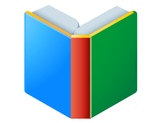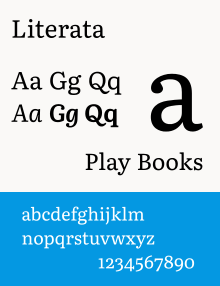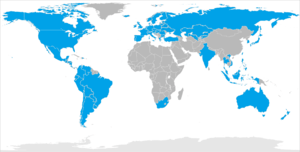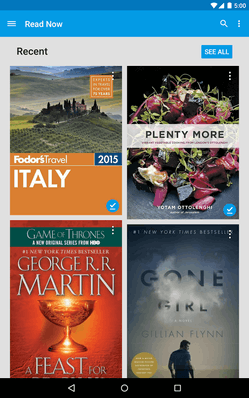Google Play Books
|
| |
|
Google Play Books on Android Lollipop | |
| Developer(s) | |
|---|---|
| Initial release | December 6, 2010 (as Google eBooks) |
| Stable release |
3.9.49
/ August 15, 2016 (Android) 2.9.3 / August 5, 2016 (iOS) |
| Development status | Active |
| Platform | Android, iOS, Chrome, web |
| Size |
11.19 MB (Android) 22.4 MB (iOS) |
| Type | Digital distribution |
| Website |
play |
Google Play Books (formerly Google eBooks) is an ebook distributor service offered by Google. Users can purchase and download ebooks from Google Play, which offers over five million ebooks and Google claims it is the world's largest e-book store. The user may also upload up to 1,000 ebooks that are in PDF or EPUB formats to their Google Play Books account cloud storage, and synchronize them between multiple devices. Uploading of digital rights management (DRM) protected ebooks purchased outside of Google Play Books is not supported.[1] The use of Google Play Books requires a Google account.
Unlike Amazon.com's Kindle Store and Apple's iBooks, the DRM system used for protected items purchased from Google Play Books is based on Adobe's open platform DRM system. This allows users to download DRM-protected books from Google Play Books in the EPUB and PDF formats, that can be transferred to and read on e-readers and apps that support Adobe Content Server 4 DRM.[2][3] The supported e-readers include the Nook and Sony Reader. DRM-protected ebooks cannot be transferred to Amazon Kindles or Apple iBooks, since they do not support Adobe's DRM. Transferring DRM-protected books to an e-reader requires the Adobe Digital Editions software to be installed on the computer.[4] Authors offering books through Google Play may choose not to enable DRM protection, in which case the downloaded ebooks can be freely transferred to other platforms including Kindle and iBooks.[5]
Books can also be read online on any web browser with JavaScript enabled.[6] Books can be read offline through official mobile apps for Android and iOS devices that were announced at the same time as the original Google eBookstore,[7] and on the Google Chrome browser on desktops through an HTML 5-based web app available from the Chrome Web Store.[8] Holding purchased books on the cloud theoretically allows Google to serve books to users in a variety of formats, including new formats that might not have been available at the time of purchase.
On 23 May 2011, Google announced on its official blog that Google eBooks was partnered with over 7,000 publishers at the time, and that the mobile apps for iOS, Android and Chrome had been downloaded more than 2.5 million times. Over 3 million free ebooks were available in the US.[9]
Publishers and authors can submit their books to Google through the Play Books Partner Centre, although new sign-ups are not currently permitted. Apart from being able to buy the ebook from Google Play, customers can preview these books through Google Books, with the publisher being able to set the percentage of the book available for preview.[10][11] Purchase of books from Google Play is currently supported in 65 countries.
History

The history of Google Play Books can be traced to the Google eBooks service offered by Google before the Google Play brand came into existence. The Google eBookstore was launched on December 6, 2010, in the United States as the world's largest ebookstore with over 3 million titles. At the time of launch, the service was partnered with over 5,000 publishers and offered over 2 million free ebooks in the US.[9] The international editions of Google eBooks were to roll out beginning in early 2011. Google eBooks was launched after many months of speculation. The service was codenamed Google Editions, the name under which it was widely assumed that the service would be launched.[12][13] Google Books director Dan Clancy had talked about Google's vision to open an ebookstore for in-print books in an interview back in July 2009.[14] Then, TechHive had reported that the service would be launched in the first half of 2010,[15] and later cited a Google employee as saying that the launch would be in June or July of the year.[16]
The store was headed by Dan Clancy, who also directed Google Books. Clancy stated that Google Editions will let publishers set the prices for their books and will accept the 'agency' model, as that of the publisher being considered the seller with the online vendor acting as an 'agent'. Clancy also stressed that Google's ebooks would be readable on any device, indicating the open nature of the platform. It would also make ebooks available for bookstores to sell, giving “the vast majority” of revenues to the store.[17] Having already digitized twelve million physical books at the time, including out-of-print titles, Google offered a far greater selection than Amazon and Apple did.[17] Salon noted that the public domain titles on Google eBookstore are of a lower quality than in competing ebookstores. One interesting aspect of public domain titles is that users can view the scanned pages of books, showing the original typeset, page numbering and even library stamps and marginalia.[18]
Introductory reading features included selecting font, font size, line spacing, and day/night reading modes, and the ability to pick up reading positions while using multiple devices.[7] The reception of Google's ebookstore was mixed. While it was praised for its promise of "seamless" cloud-based consumer access to purchased ebooks, it was noted by Salon.com that the ebookstore was not easy to search, and its integration with Google Books was somewhat awkward. Search results even included every publication that simply mentioned the search terms. Salon also noted that Google eBookstore's poor user interface was about as dismal as that of iBooks Store, and was seemingly designed by people knowing nothing about the book trade.[18]
On June 16, 2011, Google introduced an affiliate program for ebooks, allowing websites to earn commissions by referring sales to the Google eBookstore. Google eBooks became listed on the Google Affiliate Network.
In February 2012, Google removed Google eBooks from the Google Affiliate Network and removed most of the smaller affiliates, and switched to accepting new affiliates on an invitation only basis.
On March 6, 2012, Google launched its new digital distribution platform Google Play, with the Google eBookstore becoming a part of it.
In April 2012, Google announced that its retailer partner program would be discontinued on 31 January 2013.
Around July 2013, Google dropped support for the wide variety of ebook file formats it used to accept for the selling on Google Play, including DOC, XML, HTML, MOBI and PDB, to focus primarily on the EPUB format. The Digital Reader noted that this policy change represented a "paradigm shift" for Google.[19]
On May 18, 2015, Google announced that a new custom-made typeface called Literata will be used for Google Play Books.[20]
From May, 2015, Google are not accepting new sign-ups to its Books Partner Centre to allow them to improve their content management capabilities and their user experience. As of August 2016 it was still closed to new partners. Current partners still have full access to the service.[21]
In June 2015, Google Play showed that the Play Books app had been downloaded over one billion times.[22]
Reseller program
Google had formed partnerships with independent bookstores, enabling them to sell Google ebooks on their websites for a cut of sales. Bookstore partners included Powell's, Alibris and participating members of the American Booksellers Association.[7] The service sought to bring independent retailers into the digital retailing, offering a turn-key service that let customers register with their local bookstores and buy Google eBooks through them, with the bookstore receiving a fee on each title. However, local stores were required to provide their own marketing and promotional support, even though many stores simply did not have the resources to do so. Booksellers were plagued by the lack of promotional support from Google and almost universal consumer ignorance of the program, and thus the partnership model did not emerge to be very successful, at least to Google.[23]
In a blog post on 23 May 2011, Google announced that it had over 250 independent bookseller partners, compared to just over 100 at the time of launch.[24]
In April 2012, Google decided to withdraw the reseller program, reasoning that "it’s clear that the reseller program has not met the needs of many readers or booksellers." Google also said that the program “has not gained the traction that we hoped it would,” even as the company's share of the ebook market in the US remained small. Retailers could sell Google's ebooks until 31 January 2013. The move came as a big blow for small bookstores seeking to compete against Amazon and Barnes & Noble in the fast growing ebook market, and attracted severe criticism from the industry. In a letter to its members, the American Booksellers Association said that it was "very disappointed" with Google’s decision, while noting that the change could be "disconcerting and disruptive" for booksellers. "As an enormous, multinational corporation, Google has interests far beyond independent bookstores, and the book world at large, and, at times, it has lacked understanding of many basic principles of our industry", the letter said.[25]
Affiliate program
In June 2011, Google launched an affiliate program for Google eBooks allowing website owners to earn a commission by referring sales to the Google eBookstore. Google had previously tested the program as a limited beta in December 2010 with Goodreads. The program was open to bloggers, authors, publishers, retailors and other website owners in the US starting on June 16, 2011.[26] Becoming an affiliate was a three-step process: users had to first sign up for a Google AdSense account and be approved, then join the Google Affiliate Network and be approved, and sign up as an affiliate for ebooks. Website owners could earn 6% to 10% of commissions depending upon the amount of sales being generated per month.[27][28]
On February 24, 2012, Google announced its decision to scale down the affiliate program, turning it into a private initiative and removing most of the affiliates. Google eBooks would no longer be listed as an advertiser on Google Affiliate Network.[29] The company had stopped accepting applications for becoming an affiliate more than two weeks prior to the announcement.[30] Those who were delinked from the program received commissions for sales up to March 15, 2012. Google said that it will continue to add affiliates, but only on an invitation basis.[31]
In a possible goof-up, Google also notified independent booksellers that their affiliate status would expire, but later clarified that it did not intend to remove independent booksellers from the affiliate program, and said that it was "working to reinstate those who were mistakenly notified."[32][31]
Features
On May 15, 2013, Google Play Books started allowing users to upload PDF and EPUB files through the Play Books web client. Users can store up to 1,000 files free of charge on the cloud, as long as they are under 100 MB. Searching within uploaded documents is not supported. Bookmarks and reading positions are synchronised across all Google Play Books apps linked to the user's account.[33][34] On December 11, 2013, the ability to upload files was extended to the Android and iOS platforms. Files cannot be uploaded from within the app; users have to open the file from a file manager application or other apps such as Mail or Downloads, and choose "Upload to Play Books" as the open-with app.[35] On December 19, 2013, the ability to upload PDFs on Android was temporarily discontinued with Google stating that it had been an experimental feature and would be back soon.[36] The functionally was reinstated through an update on January 29, 2014. However, users first need to enable the PDF upload in the settings.[37]
Google Play Books on Android and iOS features three reading themes:
- Day: Black text on a white background
- Night: White text on a black background
- Sepia: Sepia (reddish-brown) text on a pale yellow background. Sepia mode was introduced for Android in September 2012[38] and for iOS in August 2013.[39]

Other reading options include choosing between multiple typefaces (including Sans, Serif, Merriweather, Sorts Mill Goudy, and Vollkorn) and adjusting the text size, line spacing and alignment. The screen brightness can be adjusted from within the app, or set to an "Auto" mode, which makes use of the system brightness. Users can add notes, highlight text and create bookmarks. These features, except for bookmarking and adjusting brightness, are not available for user uploaded PDF books. Notes and highlights in ebooks can only be accessed through the web reader or mobile apps, and not on e-readers. They can also be accessed in the Chrome app, but not while offline.
On Android and iOS, Play Books features a 3D page turn effect, though users have the option to switch to a 2D sliding page turn animation. It also allows users to turn pages using the volume keys.[40] The Play Books web client only supports the 2D page turn animation.[41]
Play Books can read aloud the text of books using the device's text-to-speech engine or Google Text-to-Speech, when the publisher allows. Reading aloud using Google Text-to-Speech requires internet connectivity.[41] Translation of book text is supported through integration with Google Translate.[38]
When a word is selected, Play Books displays an info card containing the dictionary definitions of the word. For words with no dictionary definition, web definitions may be displayed. If the selected word is the name of a geographical location, a Google Maps snapshot may also be displayed.[38]
All items in the users' Google Play Books library also belong to the Google Books library where they are displayed in a bookshelf titled My Books on Google Play (formerly called My Google ebooks, before the Google Play branding came into effect). Google Play Books library, therefore, is a subset of the Google Books library.
On Android, the home screen (Read now) shows the recently opened books at the top, along with book recommendations and books +1'd by friends. The My Library section shows all the books grouped into three categories: Purchases, Samples and Uploads. Books can be "kept on device" for offline reading.[41]
On October 30, 2014, Google released an update for Google Play Books on Android adding a number of features specifically aimed at improving the user experience for long non-fiction books. These included a 'Skim' mode, which allows users to easily navigate through pages without having to endlessly flip through each page.[42]
On December 15, 2015, the application was updated to include a feature named "Night Light" which gradually filters blue light from the screen, in an attempt to alleviate eye strain.[43][44]
Books on Google Play
| Pricing model | Varies by country |
|---|---|
| Format | EPUB, PDF |
| Restrictions | Adobe DRM scheme |
| Preview | Free chapters from every book |
| Availability | 65 countries |
| Website |
play |
The Google Play store serves as the primary source of ebooks for reading on Google Play Books. Over five million titles are available for purchase or free download. Select books, mainly textbooks, are also available for rental. The rental period starts as soon as the payment is completed.[45] Google Play also allows users to pre-order ebooks in cases where they are available on Google Play before they are released. The customer is not charged until the ebook is available for reading. Not all ebooks, however, are available for pre-order.[46]
File formats
Originally, Google used to allow publishers and authors to upload books in a number of formats including DOC, PDF, PDB, MOBI, EPUB, and HTML. But in July 2013, support for all these formats except for PDF and EPUB was dropped. As of now, Google accepts EPUB versions 2.0.1 and 3.0. Both text and image-based PDFs are accepted when the EPUB format is not available, with the preference being for PDFs with a text layer.[47]
For reading on e-readers or third-party apps, ebooks can be downloaded in the EPUB ("flowing text") or PDF ("scanned pages") formats. The advantage of EPUB has over PDF is that it allows the book's text to adjust or 'reflow' automatically to different screen sizes. Books of which only a PDF version is available can be difficult to read on smaller screens.[48]
Availability

Purchase of books from Google Play is currently supported in the following countries: Argentina, Australia, Austria, Belarus, Belgium, Bolivia, Brazil, Canada, Chile, Colombia, Costa Rica, Czech Republic, Denmark, Dominican Republic, Ecuador, El Salvador, Estonia, Finland, France, Germany, Greece, Guatemala, Honduras, Hong Kong, Hungary, India, Indonesia, Ireland, Italy, Japan, Kazakhstan, Kyrgyzstan, Latvia, Lithuania, Luxembourg, Malaysia, Mexico, Netherlands, New Zealand, Nicaragua, Norway, Panama, Paraguay, Peru, Philippines, Poland, Portugal, Romania, Russia, Singapore, South Africa, South Korea, Spain, Sweden, Switzerland, Taiwan, Thailand, Turkey, Ukraine,United Arab Emirates,United Kingdom, United States, Uruguay, Uzbekistan, Venezuela, and Vietnam.[49]
References
- ↑ "Upload & read documents". Google Play Help. Google. Retrieved 6 May 2015.
- ↑ "Google eBooks Help". Changing Hands bookstore. Retrieved 11 November 2014.
- ↑ "Google adopts Adobe eBook DRM". Adobe. 6 December 2010.
- ↑ "Download & transfer books to eReaders". Google Play Help. Google. Retrieved 12 November 2014.
- ↑ "Digital Rights Management". Google Play Books Partner Program Help. Google. Retrieved 6 May 2015.
- ↑ "Supported reading devices". Google Play Help. Google. Retrieved 12 November 2014.
- 1 2 3 "Discover more than 3 million Google eBooks from your choice of booksellers and devices". Official Google Blog. Google. 6 December 2010.
- ↑ "Read books offline". Google Play Help. Google. Retrieved 5 June 2014.
- 1 2 Juan Carlos Perez (23 May 2011). "Google Touts Growth of E-book Service and Store". PC World.
- ↑ "Partner Centre overview". Google. Retrieved 12 November 2014.
- ↑ Stephanie Chandler (January 11, 2011). "How to Submit Your Book to Google Ebooks". Authority Publishing.
- ↑ Andrew Albanese (6 December 2010). "Google Launches Google eBooks, Formerly Google Editions". Publishers Weekly.
- ↑ "Google Editions Released as Google eBooks". Littlefish managed IT services. 6 December 2010.
- ↑ Frederic Lardinois (31 July 2009). "Google's Vision for the Future of Google Books: EBook Store, Google Editions". Readwrite.
- ↑ Ian Paul, PCWorld (16 October 2009). "Google Editions Embraces Universal E-book Format". TechHive.
- ↑ Jared Newman (4 May 2010). "Google to Launch E-book Store Early Summer". TechHive.
- 1 2 Ken Auletta (26 April 2010). "Publish or Perish". The New Yorker.
- 1 2 Laura Miller (8 December 2010). "Is Google leading an e-book revolution?". Salon.
- ↑ Nate Hoffelder (2 July 2013). "Google Is Considering eBook Rentals, Now Accepts Epub3". The Digital Reader.
- ↑ Google Play on Twitter: "Introducing Google Play Books' new font, Literata. Perfect for long reads on all devices.". 18 May 2015
- ↑ Google response to user query. 21 May 2015
- ↑ Google Play Books Reaches a Billion Installs – Are Your eBooks Available There?. Retrieved 9 June 2015
- ↑ Calvin Reid (6 April 2012). "With End of Retailer Program, Google Rebrands Its Digital Content Under Google Play". Publishers Weekly.
- ↑ "Google eBooks: By the Numbers, Then and Now". Google Books Search Blog. 23 May 2011.
- ↑ Laura Hazard Owen (5 April 2012). "Google: No more e-books for indie booksellers". GigaOm.
- ↑ "Google eBooks Affiliate program - Open for business". Google Books Search Blog. 16 June 2011.
- ↑ "Updated: Google Launches Ebook Affiliate Program; Rate Higher Than Amazon's". GigaOm. 16 June 2011.
- ↑ Mark Muller (4 August 2011). "Here's How to make Money from selling Google eBooks". Bright Hub.
- ↑ Laura Hazard Owen (24 February 2012). "Google Scales Back E-Book Affiliates Program, Drops Some Users". GigaOm.
- ↑ Judith Rosen (22 February 2012). "What's Up with the Google Affiliate Program?". Publishers Weekly.
- 1 2 Nate Hoffelder (24 February 2012). "Update: Google Now Thinning the Ranks of the eBookstore Affiliate Program". The Digital Reader.
- ↑ Judith Rosen (23 February 2012). "Google Drops Bookstore Affiliates". Publishers Weekly.
- ↑ "Google Play Books enables user ebook uploads, Google Drive support". The Verge. 2013-05-15. Retrieved 2013-05-16.
- ↑ "Troubleshooting file uploads with Google Play Books". Retrieved 6 March 2014.
- ↑ David Beren (11 December 2013). "New Google Play Books update includes uploading your own EPUB or PDF files". 9to5 Google.
- ↑ Shawn De Cesari (19 December 2013). "Google Play Books Update Removes PDF Uploads From App - Will Return At Some Point". Android Police.
- ↑ Liam Spradlin (29 January 2014). "Google Play Books Again Able To Upload PDF Files On The Go With New Update". Android Police.
- 1 2 3 "Turning the page with a new Google Play Books app for Android". Official Android Blog. Google. 24 September 2012.
- ↑ Aldrin Calimlin (8 August 2013). "Google Play Books For iOS Updated With Support For Rental Textbooks". App Advise.
- ↑ "Google Play Books app features & settings". Google Play Help. Google. Retrieved 11 January 2015.
- 1 2 3 Justin Dennis (21 May 2014). "Reading A Book On Your Android Device? Google Play Books Makes It Easy". Make Use Of.
- ↑ Nathan Ingraham (30 October 2014). "Google Play Books is now a lot better for reading nonfiction titles like textbooks". The Verge.
- ↑ Hartrell, Greg (December 15, 2015). "Silent Night with Night Light". Official Android Blog. Google. Retrieved March 24, 2016.
- ↑ Ruddock, David (December 15, 2015). "Google Play Books 3.7.45 Adds A "Night Light" That Makes Evening Reading Easier On Your Eyes". Android Police. Retrieved March 24, 2016.
- ↑ "Rent textbooks & books". Google Play Help. Google. Retrieved 7 January 2015.
- ↑ "Pre-order books". Google Play Help. Google. Retrieved 7 January 2015.
- ↑ "Publisher Programme Policies for Books on Google Play". Google. Retrieved 7 January 2015.
- ↑ "File types for reading on your device". Google Play Help. Google. Retrieved 7 January 2015.
- ↑ "Country availability for apps & digital content". Google. Retrieved 11 January 2015.

